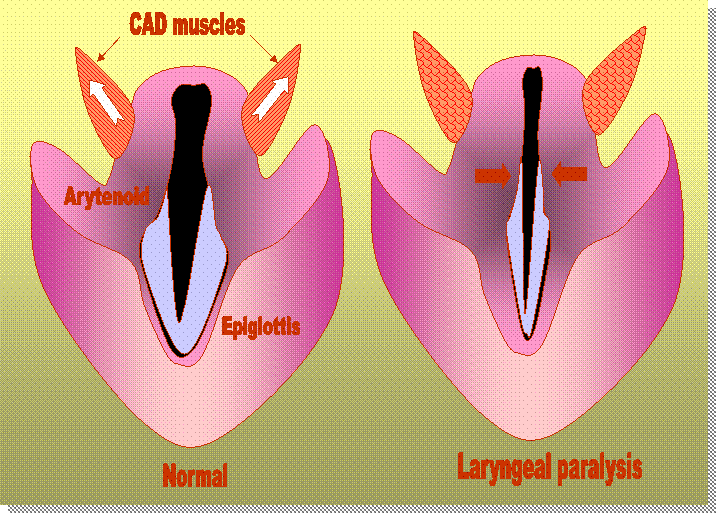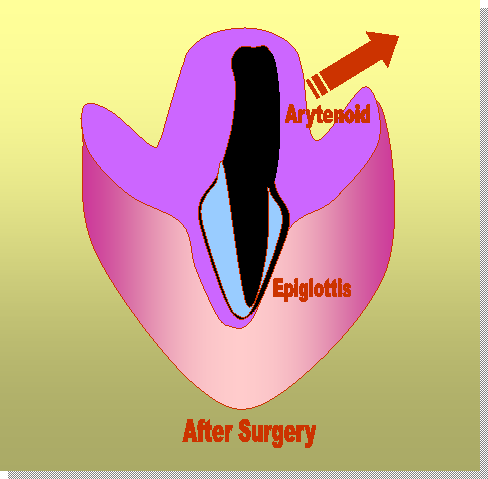Key Points
Laryngeal paralysis is a condition in which the muscles of the voice box are paralyzed, thus when a dog breathes in the voice box opening closes down and the dog can not inspire
Surgery is important to help with breathing and prevent a respiratory crisis during warm weather conditions
Prognosis is good with the surgery if the dog does not have any concurrent swallowing difficulties
Introduction – What is it?
- The larynx is commonly known as the voice box. It contains the vocal cords, which allow vocalization in dogs and cats. The larynx is the first part of the airway that prevents anything but air from getting into the trachea (windpipe). In essence it is the gateway to the airways and lungs.
- The front part of the larynx has a pair of doors which are the arytenoid cartilages. The doors open during inspiration (breathing in) by the pull of the cricoarytenoid dorsalis (CAD) muscle.
- In order to examine the larynx your pet will be lightly anesthetized. As the pet breathes in and out the function of the larynx is evaluated.
- Illustration below left of a normal larynx (voice box) – Take note of the CAD muscles (red striped structures) which pull on the arytenoid cartilages and open the airway (black slit). The pale blue structures are the vocal cords; the epiglottis is a valve or flap that folds over the larynx during swallowing to prevent aspiration of food and water.
- Illustration below right demonstrates laryngeal paralysis – When the CAD muscles are paralyzed, the arytenoid cartilages are not pulled back, which results in a narrowed airway (black slit). When the pet tries to breathe in, the negative pressure from the windpipe will also pull the arytenoid cartilages together (red arrows), which even further compromises the airway.

Laryngeal tie-back surgery
- A major contraindication against this surgery is swallowing difficulties or regurgitation as these dogs will get pneumonia after surgery.
- In preparation for surgery, your pet will be anesthetized. The side of the neck (usually the left) is shaved. An incision is made on the side of the neck over the larynx. Two nondissolving sutures are used to replace the left CAD muscle. The arytenoid cartilage is therefore “tied-back” in an open position.
- Only one side of the larynx is tied open. If both sides of the larynx are tied open at the same time, the risk for pneumonia is increased.
- Below is a an illustration of a larynx after tie-back surgery has been completed; the arrow represents the direction of pull of the suture that is placed to hold the arytenoid cartilage open.

After care and convalescence
- After surgery has been completed intensive care must be provided for the best chance for a successful outcome. Intravenous fluids may be continued over night. Most patients having a routine tie-back surgery are discharged from the hospital the next day after surgery.
- After your pet leaves the hospital pain is controlled with oral medication if needed.
- Antibiotics may be prescribed to your pet if the surgeon feels that this is needed.
- The feeding and water bowls should be elevated about 8 to 10 inches off of the floor. Canned food should be cut into chunks for the couple of weeks. Kibble could also be moistened with warm water before it is fed. Which ever food type seems to cause less coughing should be fed. Dry kibble should be avoided for the pet’s life.
- Dusty environments should be avoided.
- Swimming will no longer be permitted. If your pet’s head would go under water, the larynx would not be able to close and drowning could occur.
- Exercise should be restricted for one month to prevent break down of the laryngeal tie-back.
- A harness should be used instead of a collar, in order to take pressure off of the windpipe and the larynx.
- Most pets do well following laryngeal tie-back surgery. Breathing is greatly improved and your pet should not get into a crisis again. Your pet likely will not be able to bark again or the bark will be hoarse. During heavy panting your pet could still have increased respiratory noise, as only one side of the larynx has been tied open and the other vocal cord may flutter as air moves in and out.
Potential complications
- As with any surgery, complications may arise. Even though rare, anesthetic death can occur. With the use of modern anesthetic protocols and extensive monitoring devices (blood pressure, EKG, pulse oxymetry, inspiratory and expiratory carbon dioxide levels, and respiration rate), the risk of problems with anesthesia is minimal.
- Infection is an unusual complication as strict sterile technique is used during the surgery and antibiotics are administered.
- Seroma formation can also occur, as there may be an empty space between the tissues. This problem in general will resolve with time. Occasionally the seroma or fluid that has built up may require draining.
- Pneumonia can occur after surgery because the airway is permanently kept open on one side. Overall, 18% of dogs that have had a tie-back surgery will develop aspiration pneumonia at some time in their life.
- Recurrence of laryngeal paralysis signs can occur if the cartilages (that are pulled open with sutures) are abnormally soft and do not hold the sutures well. In the event that this occurs, surgery can be done on the other side of the larynx.
- Coughing is a expected following tie-back surgery on the larynx. Usually coughing is associated with drinking or eating. Within 6 weeks this usually improves, but occasional cough can occur. If the cough becomes deep and productive, or your dog becomes depressed, you should alert us as pneumonia may be developing.


